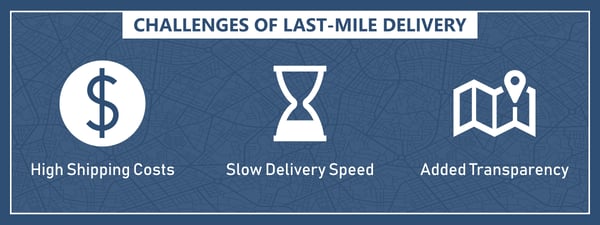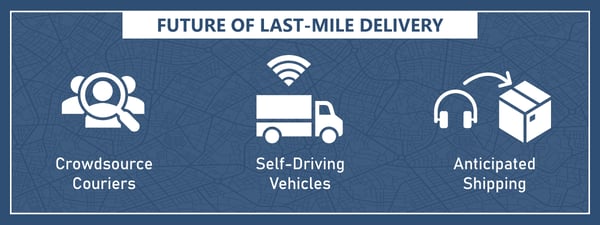
Everything You Need to Know About Last-Mile Delivery
The logistics behind last-mile delivery is more complicated than simply shipping from point A to point B. Here’s everything you need to know about last-mile delivery, including its challenges and trends.
Each stage of the logistics process of delivering products to the customer is important, but if there’s a stage that can use a little more attention, it’s the last mile just before the package lands in the customer’s hands.
What is Last-Mile Delivery?
If you’ve ever tracked your package online and the tracking service says: “Out for Delivery,” that’s the last-mile delivery. It’s the last step of the shipping process that ends with your package in hand. Last-mile delivery is defined as the movement of goods from a warehouse or transportation hub to its final delivery destination.
The goal of last-mile logistics is to deliver the packages to the buyer as quickly as possible. According to a 2018 consumer study, more than half (54 percent) of U.S. consumers say that they have abandoned their online shopping cart because delivery was too expensive. Customers can easily find alternative options if the shipping options provided don’t meet their expectations in terms of cost and/or speed. Subsequently, this makes last-mile delivery an important element of the supply chain for companies to focus on.

What Challenges are Involved with Last-Mile Delivery?
The overall challenges of last-mile delivery are cost, speed, and transparency. Identifying what your company’s weak points are leads you to the first step of tackling issues effectively. Your business can then improve customer delivery experience by taking control of the order fulfillment process.
Shipping Costs are Too High
The last-mile delivery section of the overall logistics process can be expensive, to both the online shopper and the business. According to a delivery report from Business Insider Intelligence, last-mile delivery costs comprise 53 percent of the total shipping cost. This is very substantial considering that more than half of consumers abandon their online purchases because of delivery costs.
Aside from the cost itself, big shippers like Amazon raised the demands for free delivery costs with enticing offers, such as “free two-day delivery” services. Customers are less willing to foot delivery fees which forces retailers and companies to shoulder the costs. Companies should understand that 83 percent of customers say that free delivery is the most critical factor when making online purchases. Cost is usually where most businesses look to improve first.
Delivery Speed is Too Slow
The efficiency of last-mile delivery depends on multiple factors that can be out of the company’s control when independent carriers are involved. The factors and challenges involved are:
- Size of the company/3PL
- Number of orders picked & packed each day
- Frequency of package pick-up by carrier
- Proximity of delivery points to the warehouse/distribution center
- Location of the warehouse, i.e. rural or urban
- Number of deliveries along the route and/or number of routes
As you can see, delivery speed is difficult to control once the package is out for delivery. For example, delivery routes may be longer in rural areas because of greater distances even with fewer stops. In contract, routes in urban areas are closer together, but there is the added issue of traffic that slows down the delivery process.
Learn how companies like Scentsy use shipping solutions to optimize and consolidate shipments for faster delivery.
Transparency is Needed
In a world of easily accessible information with the help of technology, the ability to track a package is almost a non-negotiable for customers. At the very least, providing the option to track a shipment would relieve some of the customer’s concerns about late delivery or missing packages. As technology increasingly improves, acting vigilant when it comes to providing transparency, such as tracking a package’s delivery status, isn’t enough anymore. There’s more to order fulfillment than you see here, such as fulfillment strategy factors and business models to follow. Empower your eCommerce fulfillment strategy with these five factors.

What Should You Look Forward to in the Future of Last-Mile Delivery?
Consumers will continuously demand cheaper and faster delivery, but the playing field is constantly changing for how companies will fulfill those needs. What works today may not work tomorrow. Be familiar with potential trends and strategies to be prepared for any changes. Keep a close ear on the industry!
Crowdsource Independent Couriers
We’re familiar with the concept of crowdsourcing local services like Uber, Airbnb, and Postmates. The actual definition of crowdsourcing is to obtain goods and/or services from a large and open group of people, generally internet users. The crowdsourcing model can be applied to last-mile delivery in which companies connect with independent couriers with their own transportation to make deliveries. This idea can exceedingly increase delivery speeds in urban areas where there is a high density of density and prospective couriers.
Self-Driving Delivery Vehicles
Automation is the way of the future. Soon, deliveries could be automated that cut the costs of labor and expands the scope of delivery systems. Of course, there are regulatory and operational issues to consider, but deliveries could be made 24 hours a day. Last year, Amazon invested over $500 million into the self-driving company Aurora and developed a working delivery system called Amazon Scout to safely delivery packages in a sustainable and automated fashion. There is a lot of potential in this concept to drive down logistic operational costs.
Anticipatory Shipping
Amazon is no stranger to innovative strategies to fulfill customer demands before the customers even know it. In 2014, Amazon patented a system that delivers products to the customers before they place the order. Essentially, the company analyzes data and past order trends to pack and ship products to local warehouses until an order is placed, like tailgating supplies around football season. Predictive analysis is a necessary and proactive method for your business to maintain a competitive edge in a fast-growing marketplace.
Regardless of your order fulfillment strategy, optimizing your last-mile delivery is evident. The solution to last-mile problems is not a one-size-fits-all situation; it’s a combination of improved technology and analytics that boosts your supply chain efficiency.
We offer ShipERP, fully integrated SAP multi-carrier shipping software for all your shipping requirements. ShipERP provides businesses with the ability to rapidly ship products during the pick/pack/ship process in real-time.

